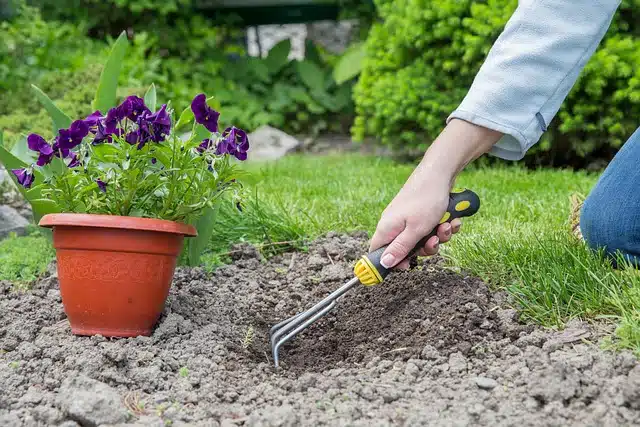A garden is a canvas for creativity, a sanctuary for relaxation, and a source of inspiration. Designing a beautiful and serene garden requires thoughtful planning, a blend of artistic vision and practicality, and a deep understanding of nature. Whether you’re starting from scratch or looking to revamp your existing outdoor space, this guide will provide you with the essential principles and tips to create a garden that appeals to the eyes and soothes the soul.
Layer Garden Planters
When you have limited horizontal space or want to add more dimension to your garden design, consider incorporating layered garden planters. This technique not only adds visual interest but also allows growing a diverse range of plants in a compact area. In this case, choose the suitable planters because this is what you need to know to create a successful and visually appealing layered planter arrangement. Whether you have a small balcony or a spacious backyard, this technique allows you to create a mini garden within a garden, adding a touch of charm and creativity to your outdoor space. With attention to detail, you can transform ordinary planters into a captivating vertical oasis that will impress all who visit your garden.
Select the Right Plants

Plants are the heart of any garden, and choosing the right ones for your garden is essential for creating a serene and beautiful space. Consider color, texture, height, and bloom time when selecting plants. Aim for a mix of evergreen and seasonal plants to maintain interest throughout the year. Integrate fragrant plants to stimulate the senses and enhance the overall ambiance. Understanding the climate and location of your garden is crucial for plant selection and design choices. Different plants thrive in other conditions, so choose varieties well-suited to your region’s climate. Incorporate native plants whenever possible, as they require less maintenance and support local ecosystems.
Nurture Helpful Insects
In addition to creating a stunning and tranquil garden, another essential aspect of garden design involves nurturing helpful insects that contribute to the overall health and balance of the ecosystem. By incorporating elements that attract beneficial insects like honey bees, ladybugs, and lacewings, you can naturally control pests and reduce the need for chemical pesticides.
Consider planting a variety of flowering plants such as lavender, marigold, and coneflower to provide these insects with nectar and pollen sources. Installing insect hotels or small shelters can offer refuge for solitary bees and other critters. Furthermore, minimizing the use of synthetic fertilizers and promoting organic practices will create a hospitable environment for these insects to thrive. By prioritizing the well-being of these tiny garden allies, you not only enhance the beauty of your outdoor space but also play a pivotal role in maintaining a resilient and vibrant ecosystem.
Create Zones and Pathways
Divide your garden into distinct zones based on your intended use and the types of plants you want to include. Common zones might consist of a relaxation area, a play area for children, a vegetable garden, and a flower bed. Connect these zones with well-designed pathways encouraging exploration and guiding visitors through your garden. Then, establish a focal point. Every beautiful garden should have a focal point that draws the eye and creates a sense of balance. This could be a striking sculpture, a serene water feature, a flowering tree, or a beautifully designed seating area. The focal point is the anchor around which you’ll build the rest of your garden’s design.
Embrace Natural Landscaping
Rather than attempting to force nature into a rigid design, work with the natural contours of your landscape. Incorporate gentle slopes, existing trees, and natural features into your design. This makes your garden look more harmonious and reduces the need for extensive earth-moving and alteration. But choose a cohesive theme that ties all the elements of your garden together, creating a sense of unity and tranquility. Whether you prefer a formal, structured garden or a more wild and rustic atmosphere, ensure that your plant choices, materials, and decorative elements align with your chosen theme.
Pay Attention to Color Palette
Color plays a significant role in the aesthetics of your garden. Decide on a color palette that resonates with the mood you want to create. Soft pastels evoke a calm and peaceful atmosphere, while bold and vibrant colors energize the space. Stick to a limited color palette to avoid visual clutter and maintain a sense of harmony. Sometimes, less is more. Avoid overcomplicating your garden design with too many elements. Embrace simplicity by leaving some areas open or focusing on key focal points. This approach reduces maintenance efforts and allows for a clearer and more serene visual experience.
Focus on Sustainability

A beautiful and serene garden should be sustainable and environmentally friendly. Embrace practices such as composting, mulching, and using organic fertilizers to nourish your plants. Implement efficient irrigation systems to conserve water, and choose plants that require minimal water once established. While designing your garden, keep in mind the maintenance it will require. Choose plants that match your commitment to upkeep, and design layouts that are manageable to maintain. Regular pruning, weeding, and caring for your garden ensure that it remains beautiful and serene over time.
Conclusion
Designing a beautiful and serene garden is a rewarding endeavor that requires a combination of artistic sensibility, horticultural knowledge, and a deep appreciation for nature. By carefully considering the purpose of your garden, working with the natural landscape, choosing the right plants, and integrating design elements that promote tranquility, you can create a space that delights the senses and nurtures the soul. Remember that a well-designed garden is a journey, not a destination, and enjoy the process of crafting your oasis of beauty and serenity.
